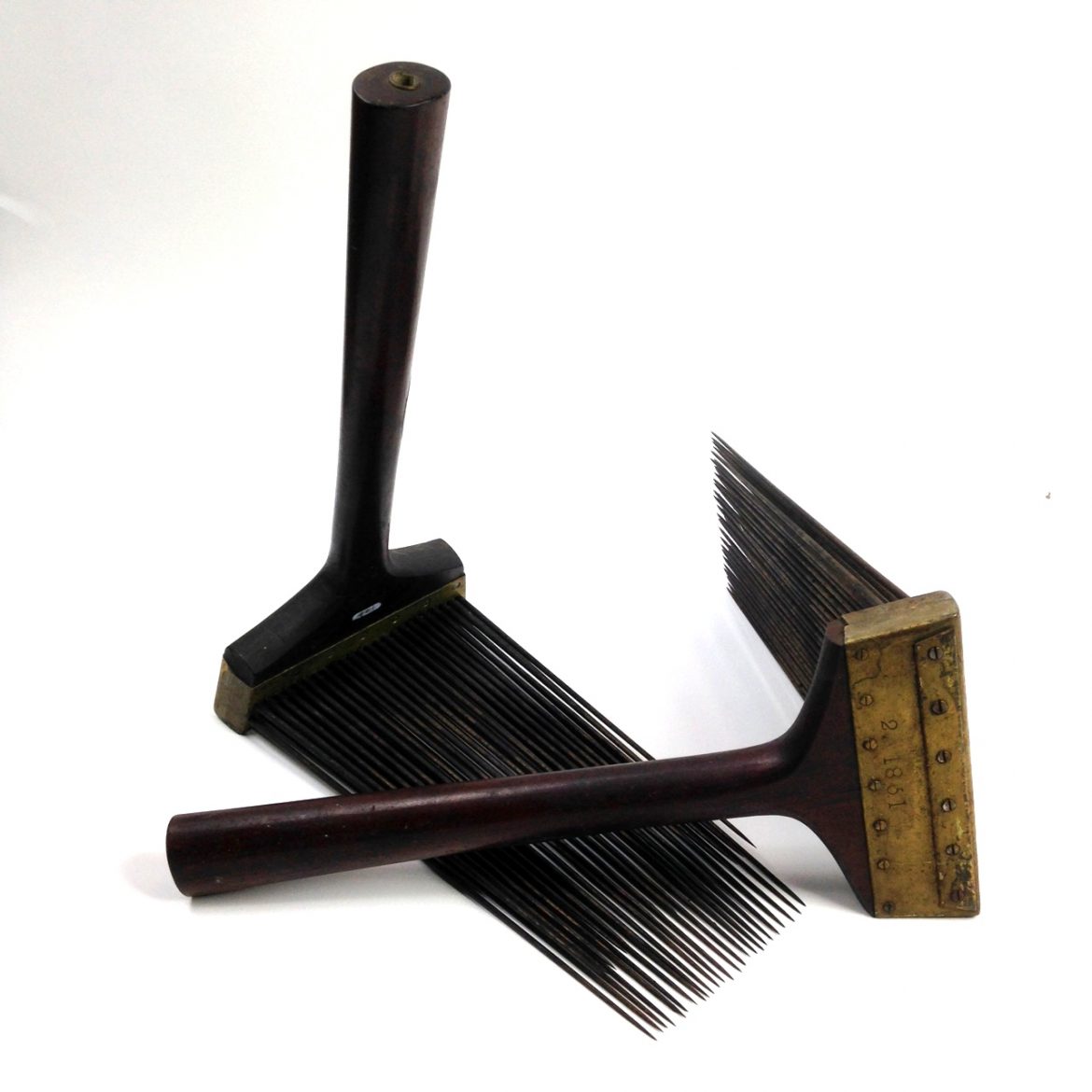
Pair of Worsted Combs, Center Family, Mount Lebanon, NY, 1851, Shaker Museum | Mount Lebanon, 1950.28.1 and 1950.32.1.
This article continues our last posting on Brother Richard Bushnell Woodrow of the Center Family Shakers at Mount Lebanon, New York. Here we describe a pair of worsted combs he made for the sisters in his family. The processing of wool for spinning is usually done in two ways – combing and carding. Combing wool […]

Pair of Worsted Combs, Center Family, Mount Lebanon, NY, 1851, Shaker Museum | Mount Lebanon, 1950.28.1 and 1950.32.1.
This article continues our last posting on Brother Richard Bushnell Woodrow of the Center Family Shakers at Mount Lebanon, New York. Here we describe a pair of worsted combs he made for the sisters in his family.
The processing of wool for spinning is usually done in two ways – combing and carding. Combing wool is the earlier of the two methods and is done to removes short fibers while aligning the long fibers. The result of combing wool is similar to combing one’s hair when the goal is to have each hair parallel to the other. Combed wool, when spun, produces a yarn with fibers that lay close to each other. The yarn is therefore smoother, stronger, and harder and produces a fabric that is cooler to wear. This fabric is ideal for men’s or women’s pants and jackets. Carding wool, in contrast, does not remove the short fibers but rather, tangles them – sort of like teasing hair – to produce a softer fluffy yarn that traps some air between the fibers. This woolen yarn retains strength from the longer fibers being twisted together, but is also soft and warm. It is perfect for woven winter coats and knit sweaters, socks, and gloves.

Pair of Worsted Combs (detail of date), Center Family, Mount Lebanon, NY, 1851, Shaker Museum | Mount Lebanon, 1950.28.1 and 1950.32.1.
Shaker Museum | Mount Lebanon has several pairs of Shaker worsted combs in its collection. The pair presented here is typical of worsted combs made for hundreds of years. This pair, and another nearly identical pair, appears to have been made by Brother Richard B. Woodrow in 1851. A Shaker journalist recorded this entry in the Center Family Journal on May 14, 1851: “Richard [Woodrow] engaged about making some new combs for the sisters to comb with this season &c.” Each of the pair of combs has the date “1851” stamped in the brass formed around the head of the combs. These combs can be described as “two pitch” combs – two pitch describing the number of rows of tines (historically called “broitches”) mounted in the head of the comb – with eleven inch tines. Combs vary from two to eight pitch with broitches as long as twelve inches. The number of rows of tines selected by a worsted comber depended on the type of wool that was being combed. These combs were acquired directly from the Church Family Shakers by Museum founder, John S. Williams, Sr., prior to 1950. At that point the remaining members of the Church Family were in residence in Ann Lee Cottage at the Center Family where Brother Richard had lived.

Postcard (20th century re-enactment of hand wool combing in late 18th century Calder valley, at Bankfield Museum, Halifax), Bankfield Museum, Halifax, England, Document ID: 100095 Library ID: 34559582.
Wool combing has a fascinating history and language. Both men and women were employed as combers. First the tines were heated on a stove; the heat made it easier for the tines to move through oily wool without tearing or breaking the fibers. The comb was mounted on a “pad” by inserting the pad’s small iron pins in the comb’s two “pad points” – one on the side of the handle and one in its end. With its tines pointing up, its handle away from the comber, the comber “lashed” on the proper amount of wool. As much of the wool as possible was put on the side of the comb opposite the handle. Once the wool was lashed on, the comb was turned on the pad with its tines horizontal to the floor. The comber then used the second heated comb to “jig” or “fetch off” the wool on the mounted comb to the free comb by using a controlled circular chopping motion – the free comb’s tines pulling though the wool perpendicular to the tines on the mounted comb. Once jigged, the combs were switched and the process repeated until the wool was sufficiently combed – each time removing the remaining short fibers (the “noils”) and saving them to be carded. The combs were re-heated as needed, even with the wool on. Once combed sufficiently, the wool was moved to the mid-point of the tines and the comber began “drawing off the sliver.” This process pulled the fibers off the tines in a prescribed way until all but the shortest fibers were left on the tines. The sliver, which should be four feet long, was laid out on a bench for evaluation and the removal of any “neps,” or foreign matter. A number of slivers were combined and rolled into a ball called a “top” and passed on to the spinners. This is the very short version of a most persnickety operation. [Source: Enid Anderson’s The Spinner’s Encyclopedia (1987).]